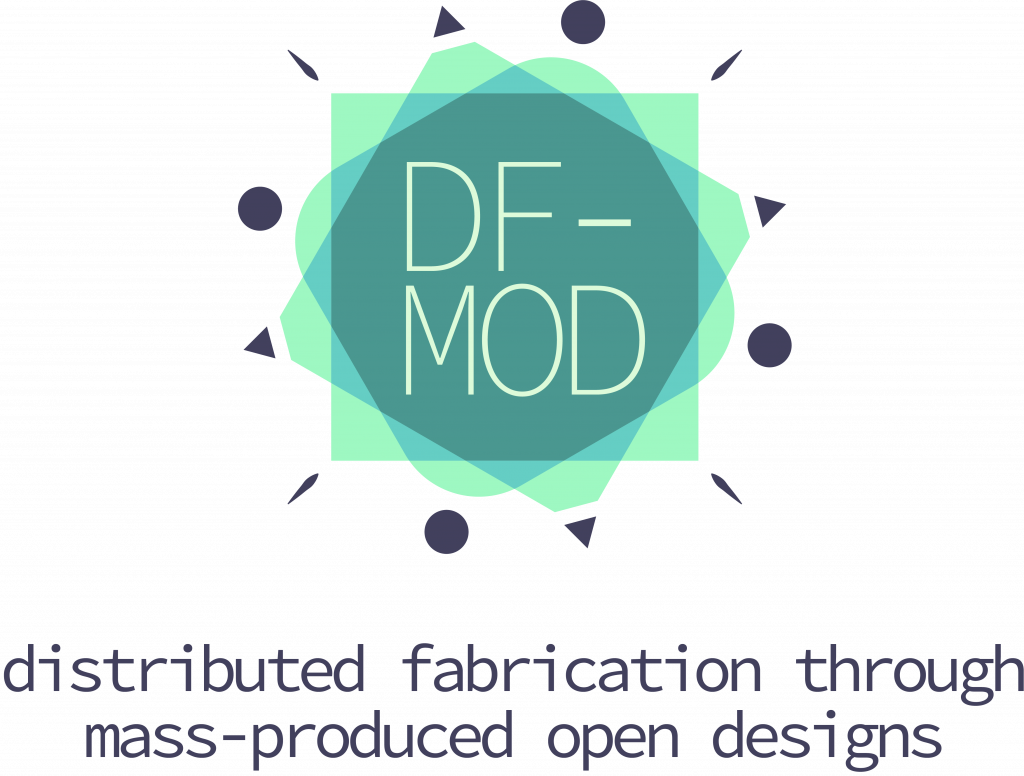Open design suggests a horizontal, self-managing collaboration through the open sharing of designs for virtually anyone to adopt, alter and fabricate.[1] It is different from more conventional forms of co-design processes that produce a final design outcome as a consensus of a group of stakeholders. Rather, the designs are reviewed and improved through peer-to-peer (p2p) feedback and can branch or fork towards a diverse range of new designs according to the needs, wants and preferences of different groups of people working on them[2]. Operationalized through the development of desktop fabrication tools such as 3D printers and laser cutters, and their increased accessibility through fabrication labs (fab labs) and maker spaces, open design espouses opportunities for more open collaborative innovation processes[3], distributed fabrication[4], self-repair[5] and a circular economy.[6]

However, there are several challenges to the broadening and inclusive innovative potential of open design due to the physicality of its outcomes.[7] The process of peer-reviewing that functions so well to find bugs and improve codes thanks to online sharing and duplication through the copy-paste function in open-source software movement, does not function that well in more complex open designs (e.g. cars, electricals) where parts and components need to be rebuilt from scratch by everyone who wants to get involved.[8] Also, since the fabrication is distributed and (in theory) everyone can fabricate open designs, the issue of reliability and user safety of open designs emerges due to the lack of oversight in fabrication processes.[9] Finally, although everyone is thought to be able to adopt, alter and fabricate these designs, only makers, prosumers and alike[10], who have the skills and resources, can get involved in this open design process in real life, especially in their fabrication.[11] In literature, alternative mass-production and business models are suggested to overcome these challenges. Highly complex or hard-to-fabricate components can be mass-produced to facilitate the peer-review of open designs and their adoption and alteration by others with the use of locally fabricated parts. [7] However, such examples do not target end-users or cannot inherently facilitate end-users’ involvement in the design and fabrication of end products.[12] Furthermore, the potential of open design and knowledge sharing is diminished without a lasting horizontal community and alternative business models supporting and mainstreaming it to reinvent and transform existing consumer products.[1] This is where DF-MOD aims to explore:
- How can mass-produced open designs enable collaboration and espouse new business models based on distributed fabrication?
- How can it expand beyond the makers and prosumers, and actively involve end-users in production, repair and re-use?
- How, and to what extent, can these open designs ensure the safety of end-users while maximizing the openness of mass-produced components and products?
- What are the opportunities and limitations of these new collaboration models in terms of value recapture and circular economy?
- How can open design reinvent what we currently perceive as consumer goods and their linear (produce-use-reduce) lifespan?
These questions will be explored with co-creation workshops facilitated through generative research methods[13] involving end-users, prosumers, makers and mass-producers, around electrical consumer goods (including, but not limited to, electrical household appliances, heating/cooling systems, etc.). This product area is selected due to the embedded value in their parts and components, their relatively shortening life-spans and the resultant waste electrical and electronic equipment (WEEE), and the types of parts and components they have in common (e.g. electric motors, heating elements, etc.) which present potentials for open design processes.

DF-MOD’s goals
- to identify the strengths and barriers of these stakeholders to operate through an open design sharing environment, and
- to explore alternative ways of collaboration and doing business facilitated through mass-produced open design parts and products, which can enable the recapture of the added value of parts and components within a circular economy through the active involvement of end-users, prosumers, makers and mass-producers in their production and post-use within a distributed network of fabrication.
This study inherently assumes an interdisciplinary approach among design, engineering and social sciences, as it involves a wide range of stakeholders collaborating in co-production and value recapture, the act of designing openly shared solutions, and mass-production of open parts and components to ensure safety and reliability, and to facilitate and sustain a horizontal community consisting of makers, prosumers and end-users.
[1] Bakırlıoğlu, Y. & Kohtala, C. (2019) Framing Open Design through Theoretical Concepts and Practical Applications: A Systematic Literature Review, Human–Computer Interaction, 34 (5-6), 389-432, DOI: 10.1080/07370024.2019.1574225
[2] Eakin, E. (2013). The civilization kit: On a farm in Missouri, a radical experiment in self-sufficiency. The New Yorker, Retrieved from https://www.newyorker.com/magazine/2013/12/23/the-civilization-kit
[3] Thackara, J. (2011). Into the Open. In van Abel, B., Klaassen, R., Evers, L. & Troxler, P. [Eds.]. Open Design Now!. Amsterdam: BIS
[4] Ramos, J. (2017). Cosmo-localization and leadership for the future. Journal of Futures Studies, 21 (4), 65–84.
[5] Bonvoisin, J. (2017). Limits of ecodesign: The case for open-source product development. Int. J.of Sustainable Engineering, 10(4–5), 198–206
[6] Prendeville, S., Hartung, G., Purvis, E., Brass, C., & Hall, A. (2016). Makespaces: From redistributed manufacturing to a circular economy. International Conference on Sustainable Design and Manufacturing 2016 Proceedings, 577-588. Springer, Cham.
[7] van der Bij, E., et al.. (2013). How to create successful open hardware projects — about white rabbits and open fields. Journal of Instrumentation 8 (12), C12021–C12021.
[8] Malinen, T., Mikkonen, T., Tienvieri, V., & Vadén, T. (2011). Community created open source hardware: A case study of “eCars – Now!”. First Monday 16 (5), Retrieved from http://firstmonday.org/ojs/index.php/fm/article/view/3357/2951
[9] Cruickshank, L., & Atkinson, P. (2014). Closing in on open design. The Design Journal, 17(3), 361–377.
[10] The term “makers” here refer to people who make things in makerspaces, and “prosumers” to users with advanced skills to alter products.
[11] Phillips, R., Ford, Y., Sadler, K., Silve, S., & Baurley, S. (2013, July 21–26). Open design: Non-professional user-designers creating products for citizen science: A case study of beekeepers. In Proceedings of DUXU 2013 Design, User Experience, and Usability (pp. 424–431). Las Vegas, NV.
[12] Callahan, C. W., & Darby, H. M. (2014). A mobile hops harvester: User-based, open source design and shared infrastructure in an emerging agricultural sector. In Proceedings of American Society of Agricultural and Biological Engineers Annual International Meeting 2014, 25–30. Montreal, Canada.
[13] Sanders, E. B. N. & Stappers, P. (2012). Convivial Toolbox: Generative Research for the Front End of Design. Amsterdam: BIS.
About the team

Yekta Bakırlıoğlu (PI) is an Assistant Professor at the Department of Industrial Design, Middle East Technical University, Turkey. He is also a researcher at the Department of Media and Visual Arts, Koç University, as part of the Pop-Machina H2020 R&I project. He was a postdoctoral researcher at the University of Limerick, Ireland, as part of the Circular Design (L4IDS) Erasmus+ KA project. His research interests include open design, design for sustainability, sustainable production and consumption and design education for sustainability.
You can visit these pages for more information about Yekta.

Gülay Hasdoğan is the Head of the Department of Industrial Design, METU since 2008, and is a Professor in the same department. She previously held various management roles, including the Assistant Dean of Faculty of Architecture, METU (2006-2010), (1997-98) and the Chairperson of Department of Industrial Design, METU (1998-2004). She is a founding member of the Industrial Designers Society of Turkey (ETMK) and she served as the President between 1996-98. In 2008 and 2010, as an Executive Committee Member of Design Turkey Industrial Design Awards for which ETMK is a partner institution, she coordinated the development of the award scheme and the evaluation process. She received her BSc in Industrial Design (1985) and MSc in Building Science (1988) from METU, and her PhD from Central Saint Martin’s College of Art and Design, London (1993). She teaches research methods and graduation projects. She has publications about the institutionalisation of industrial design, design education and user models in the design process.
You can visit these pages for more information about Gülay.
About the host
A leading provider of undergraduate industrial design education and a pioneer in its field, METU Department of Industrial Design attracts students with the most competitive profile in Turkey. The Department features an educational approach that encourages critical and reflective thinking. Design studios, where student projects are conducted in collaboration with local, national and international partners from diverse sectors, and the open jury system are the core elements of our education. The Graduation Projects Exhibitions, staged every year since 2002, has exhibited student projects advised by around one hundred different participating firms. In recent years, the Department has also taken significant steps towards integrating design considerations for sustainability into its educational approach. We are committed to empowering our graduates to become creative, visionary, socially and environmentally aware members of the local and global professional design community.




